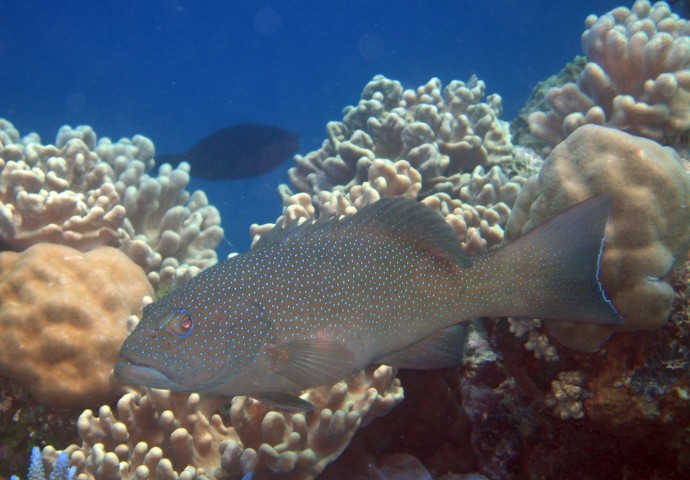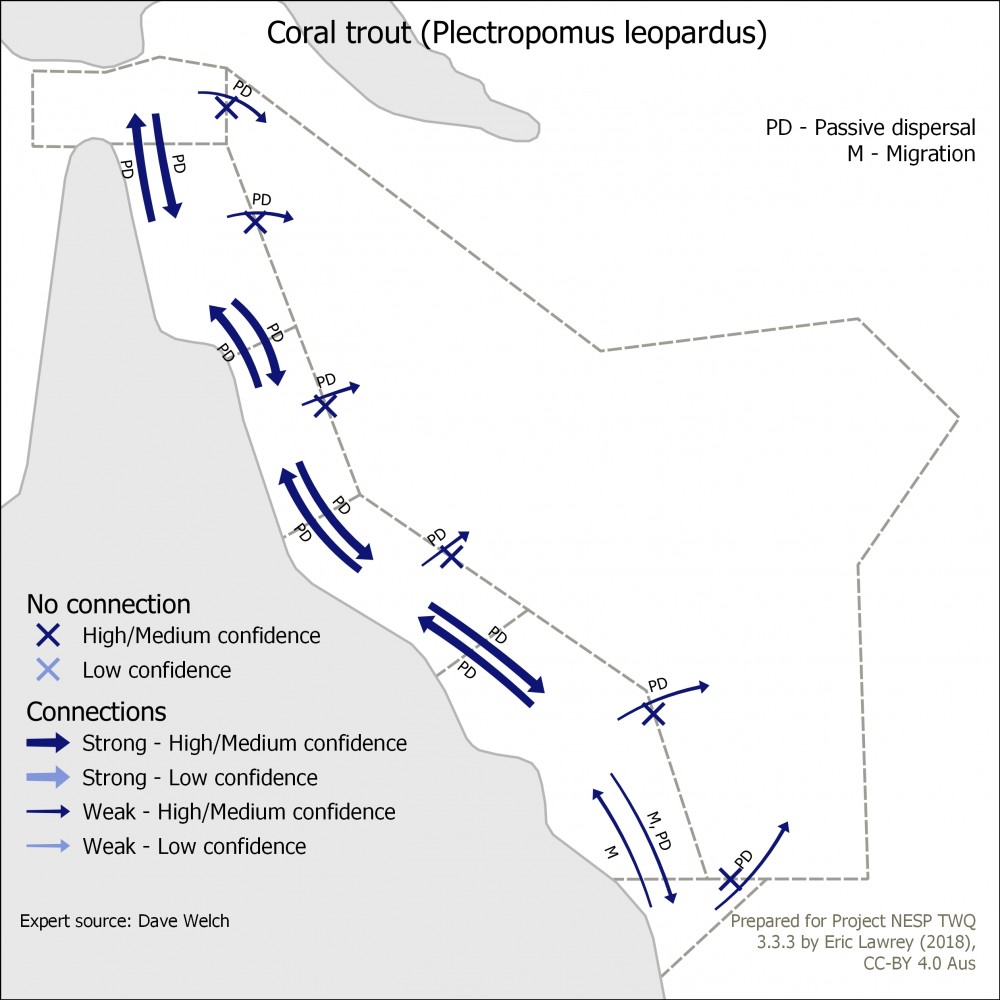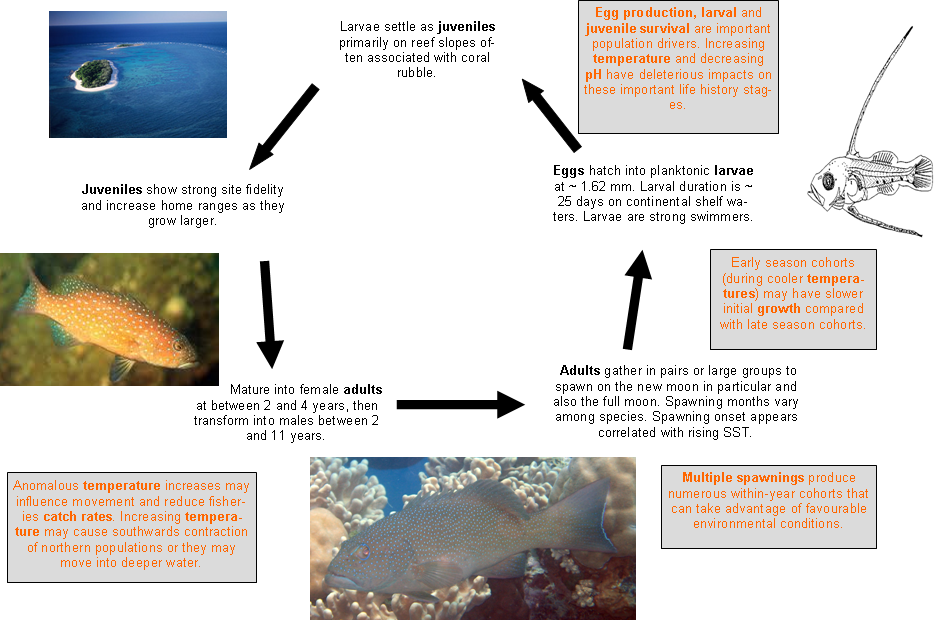Common coral trout
Introduction to the common coral trout and why they are important
The common coral trout (Plectropomus leopardus) are ubiquitous in Queensland east coast waters, and as such are an iconic and popular target species for all fishery sectors. They are the predominant target species for the Queensland Great Barrier Reef line fishery (RLF) historically comprising approximately 50% of the total catch (Welch et al, 2008) and are also heavily targeted in Torres Strait (Williams et al 2008). On the GBR and Torres Strait P. leopardus are found across the continental shelf from inshore reefs and headlands to offshore barrier reefs, however they are most common on mid-shelf reefs (Newman et al, 1997; Williams, 2008). Areas south of the GBR are generally outside their predominant range but coral trout do occur there year round.
Key concepts that relate to connectivity
Coral trout spawn either in pairs, small groups or large (>100 individuals) aggregations with peak spawning activity during new moons from September – December (Ferreira, 1995; Samoilys, 1997; Samoilys and Squire, 1994). The planktonic larval duration is approximately 25 days (Doherty, 1996; Masuma et al, 1993). Once hatched, larvae show competent swimming capabilities with directional movement (Leis and Carson-Ewart, 1999). Variation in annual egg production, and in the survival of larval and juvenile stages, is significant and an important driver of population dynamics of coral trout with strong recruitment cohorts persisting over many years (Doherty and Williams, 1988; Doherty, 1996; Russ et al, 1996). Juvenile settlement occurs on reefs, primarily on reef slopes deeper than 4 m and they show a strong preference for habitat with a high proportion of coral rubble, algae, sand and rock. Recruits also show strong site fidelity and increase their home range size as they grow in size (Light, 1995).
Using otolith morphology and microchemistry in P. leopardus on the GBR, Bergenius et al (2005, 2006) identified discrete stocks at scales of tens to hundreds of kilometres. Given the limited movement of adult fish showing that inter-reef movements are rare (Davies 1996; Matley et al 2015; Zeller 1997), the stock structure of common coral trout seems to be driven primarily by larval dispersal. When occasional gene flow does occur, it is typically unidirectional and aligned with major oceanic currents (van Herwerden et al. 2009). Together, these results indicate that P. leopardus populations are maintained by both high levels of self-recruitment and larval exchange between discontinuous reefs separated by intermediate distances (tens to hundreds of kilometres) (Frisch et al 2016).
References
Davies, C.R. (1996) Inter-reef movement of the common coral trout, Plectropomus leopardus. Final report to the Great Barrier Reef Marine Park Authority, Australia, January, 1996. 59pp
Doherty, P.J. (1996) The early life history of the common coral trout. Report CRC Reef Research, Australian Institute of Marine Science, Townsville, 54pp.
Doherty, P.J. and Williams, D.McB. (1988). The replenishment of coral reef fish populations. Oceanogr. Mar. Biol. A. Rev., 26: 487B551.
Ferreira, B.P. (1995). Reproduction of the common coral trout Plectropomus leopardus (Serranidae: Epinephilinae) from the central and northern Great Barrier Reef, Australia. Bulletin of Marine Science, 56: 653B669.
Frisch, A.J., Cameron, D.S., Pratchett, M.S., Williamson, D.H., Williams, A.J., Reynolds, A.D., Hoey, A.S., Rizzari, J.R., Evans, L., Kerrigan, B., Muldoon, G.M., Welch, D.J. and Hobbs, J-P.H. (2016) Key aspects of the biology, fisheries and management of coral grouper. Rev. Fish Biol. Fisheries, DOI 10.1007/s11160-016-9427-0.
Leis J.M. and Carson-Ewart, B.M. (1999) In situ swimming and settlement behaviour of larvae of an Indo-Pacific coral-reef fish, the coral trout Plectropomus leopardus (Pisces: Serranidae). Mar Biol 134:51–64
Light, P.L. (1995). The early life history of coral trout (Plectropomus leopardus) at Green and Arlington reefs. PhD thesis, James Cook University, Townsville.
Masuma, S., Tezuka, N. and Teruya, K. (1993). Embryonic and Morphological Development of Larval and Juvenile Coral Trout, Plectropomus leopardus. Japan. J. Ichthyol., 40(3): 333B342.
Matley, J.K., Heupel, M.R. and Simpfendorfer, C.A. (2015) Depth and space use of leopard coralgrouper Plectropomus leopardus using passive acoustic tracking. Mar Ecol Prog Ser 521:201–216
Newman, S.J., Williams, D. McB. And Russ, G.R. (1997) Patterns of zonation of assemblages of the Lutjanidae, Lethrinidae, and Serranidae (Epinephelinae) within and among midBshelf and outerBshelf reefs in the central Great Barrier Reef. Marine and Freshwater Research, 48: 119B128.
Russ, G.R., Lou, D.C. and Ferreira, B.P. (1996). Temporal tracking of a strong cohort in the population of a coral reef fish, the coral trout, Plectropomus leopardus (Serranidae: Epinephelinae), in the central Great Barrier Reef, Australia. Can. J. Fish. Aquat. Sci., 53: 2745B2751.
Samoilys, M.A. (1997) Periodicity of spawning aggregations of coral trout Plectropomus leopardus (Pisces: Serranidae) on the northern Great Barrier Reef. Marine Ecology Progress Series, 160: 149B 159.
Samoilys, M.A. and Squire, L.C. (1994). Preliminary observations of the spawning behaviour of coral trout, Plectropomus leopardus (Pisces: Serranidae), on the Great Barrier Reef. Bulletin of Marine Science, 54: 332B342.
Welch, D.J., Begg, G., and Mapstone, B.D. (2008). Discard rates and the effects of management in the commercial reef line fishery, Great Barrier Reef, Australia. Fisheries Research, 90: 247B260.
Welch, D.J. (2014) Coral trout (Plectropomus spp.), In: Welch, D.J., J. Robins, and T. Saunders (editors) (2014) Implications of climate change impacts on fisheries resources of northern Australia. Part 2: Species profiles. Final report to Department of Agriculture, Fisheries and Forestry, and the Fisheries Research and Development Corporation, Canberra, Australia. https://docs.wixstatic.com/ugd/9d521f_3bdc7908b0b84f25a8a17caf74903dac.pdf
Williams, A.J. Currey, L.M., Begg, G.A., Murchie, C.D. and Ballagh, A.C. (2008) Population biology of coral trout species in eastern Torres Strait: implications for fishery management. Continental Shelf Research, 28: 2129B2142.
van Herwerden, L., Choat, J.H., Newman, S.J., Leray, M. and Hillersoy, G. (2009) Complex patterns of population structure and recruitment of Plectropomus leopardus (Pisces: Epinephelidae) in the Indo-West Pacific: implications for fisheries management. Mar Biol 156:1595–1607
Zeller, D.C. (1997) Home range and activity patterns of the coral trout Plectropomus leopardus (Serranidae). Mar. Ecol. Prog. Ser., 154: 65-77.







